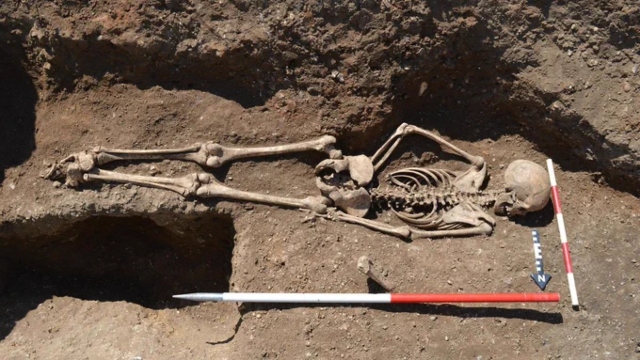
-
Medieval Girl Found Buried Face Down, Ankles Tied, To Prevent Her ‘Returning From The Grave’
18 Aug 2023 by Heinrich in Tech/Sci, World
[imagesource:befunky]
Archaeologists have found remains of a young Medieval girl, who was buried face down with her ankles tied together, suggesting extra measures were taken to ensure she could not ‘return’ from the grave.
The corpse of the 15-year-old was found in a pit at an Early Medieval settlement near the southeastern English village of Conington in the county of Cambridgeshire, during an excavation that took place between 2016 and 2018.
The remains have now been analysed by archeologists.
While Early Medieval England did not have set burial traditions, it was common practice at the time for the body of the deceased to be arranged facing upward, which makes her position even more intriguing.
According to the Museum of London Archaeology (MOLA), “To be buried face-down is thought to have been a social expression of ‘otherness’, a burial practice reserved for people considered outside of Early Medieval society – this includes those who looked or acted differently from the rest of the community.”
[image:twitter/livescience]
Osteologists – bone specialists – at MOLA found evidence to suggest the girl was of low social status. Radiocarbon dating was used to reveal that the child died between 680 AD and 880 AD.
They suspect she died suddenly or unexpectedly, as her bones didn’t show signs of a long, serious illness. There was evidence that she suffered from childhood malnutrition and analysis of her spine revealed that she had spinal joint disease, which would have been worsened by her carrying out tough manual labor from a young age, according to the release.
“We will probably never know exactly how this young woman was viewed by the community she grew up in, but the way she was buried tells us she was almost certainly seen as different.”
There seems to have been no such thing as ‘just being quirky or weird’ in Medieval times, meaning most of Cape Town’s trancies would have had a hard time back in the ol’ days.
“This burial provides an interesting, albeit tragic, opportunity to view the realities of life, and death, for those seen as outsiders in the past.”
The placement of the child’s body also made the location of her burial seem significant. The girl’s body was put in a pit that had previously held a large wooden post for the entry gate of an enclosure, and the fact that her ankles were tied together shows that the community took extra measures to ensure she would not be able to ‘return from the grave’.
There are similarities to another woman who was found buried along the boundaries of an 8th-century settlement. That woman, thought to have been executed, was missing her arms, head, neck, and part of her spine.
Borders and boundaries seemed to be used for “significant or unusual” burials in England during that period.
[source:cnn]
Latest News
-
Game, Seth, Match – Goodbye 2024
Hey Guys - thought I’d just give a quick reach-around and say a big thank you to our rea...
-
Breakfast Of Champions: Hollywoodbets Kenilworth Racecourse Breakfast Gallops Is Back!
[imagesource:CapeRacing] For a unique breakfast experience combining the thrill of hors...
-
Need NYE Plans? Cafe Caprice’s Night Of Enchantment Masquerade Party Could Do The Trick
[imagesource:howler] If you're still stumped about what to do to ring in the new year -...
-
Buckingham Palace Steps In After Staff Christmas Party Spirals Out Of Control
[imagesource:maxandeli/facebook] It's not just in corporate that staff parties get a li...
-
Designer Babies Are Running Into Trouble As Teens, Grappling With Being ‘Experiments’
[imagesource:here] Imagine being born with the weight of your parents’ version of per...
-






























